Android 16 為開發人員推出了強大的新功能和 API。下列各節會概述這些功能,協助您開始使用相關 API。
如需新增、修改及移除 API 的詳細清單,請參閱 API 差異比較表。如要進一步瞭解新的 API,請參閱 Android API 參考資料 - 新的 API 會醒目顯示,以利於查看。您也應檢查平台變更可能對應用程式造成影響的層面。如需詳細資訊,請參閱以下頁面:
核心功能
Android 包含可擴充 Android 系統核心功能的新 API。
2025 年推出兩個 Android API
- This preview is for the next major release of Android with a planned launch in Q2 of 2025. This release is similar to all of our API releases in the past, where we can have planned behavior changes that are often tied to a targetSdkVersion.
- We're planning the major release a quarter earlier (Q2 rather than Q3 in prior years) to better align with the schedule of device launches across our ecosystem, so more devices can get the major release of Android sooner. With the major release coming in Q2, you'll need to do your annual compatibility testing a few months earlier than in previous years to make sure your apps are ready.
- We plan to have another release in Q4 of 2025 which also will include new developer APIs. The Q2 major release will be the only release in 2025 to include planned behavior changes that could affect apps.
In addition to new developer APIs, the Q4 minor release will pick up feature updates, optimizations, and bug fixes; it will not include any app-impacting behavior changes.

We'll continue to have quarterly Android releases. The Q1 and Q3 updates in-between the API releases will provide incremental updates to help ensure continuous quality. We're actively working with our device partners to bring the Q2 release to as many devices as possible.
Using new APIs with major and minor releases
Guarding a code block with a check for API level is done today using
the SDK_INT constant with
VERSION_CODES. This will continue
to be supported for major Android releases.
if (SDK_INT >= VERSION_CODES.BAKLAVA) {
// Use APIs introduced in Android 16
}
The new SDK_INT_FULL
constant can be used for API checks against both major and minor versions with
the new VERSION_CODES_FULL
enumeration.
if (SDK_INT_FULL >= VERSION_CODES_FULL.[MAJOR or MINOR RELEASE]) {
// Use APIs introduced in a major or minor release
}
You can also use the
Build.getMinorSdkVersion()
method to get just the minor SDK version.
val minorSdkVersion = Build.getMinorSdkVersion(VERSION_CODES_FULL.BAKLAVA)
These APIs have not yet been finalized and are subject to change, so please send us feedback if you have any concerns.
使用者體驗和系統使用者介面
Android 16 可讓應用程式開發人員和使用者更靈活地控管裝置,以符合自身需求。
以進度為主軸的通知
Android 16 推出以進度為主的通知,協助使用者順暢追蹤使用者啟動的端對端歷程。
Notification.ProgressStyle 是一種新的通知樣式,可讓您建立以進度為主的通知。主要用途包括共乘、外送和導航。在 Notification.ProgressStyle 類別中,您可以使用點和區隔,表示使用者歷程中的狀態和里程碑。
To learn more, see the Progress-centric notifications documentation page.
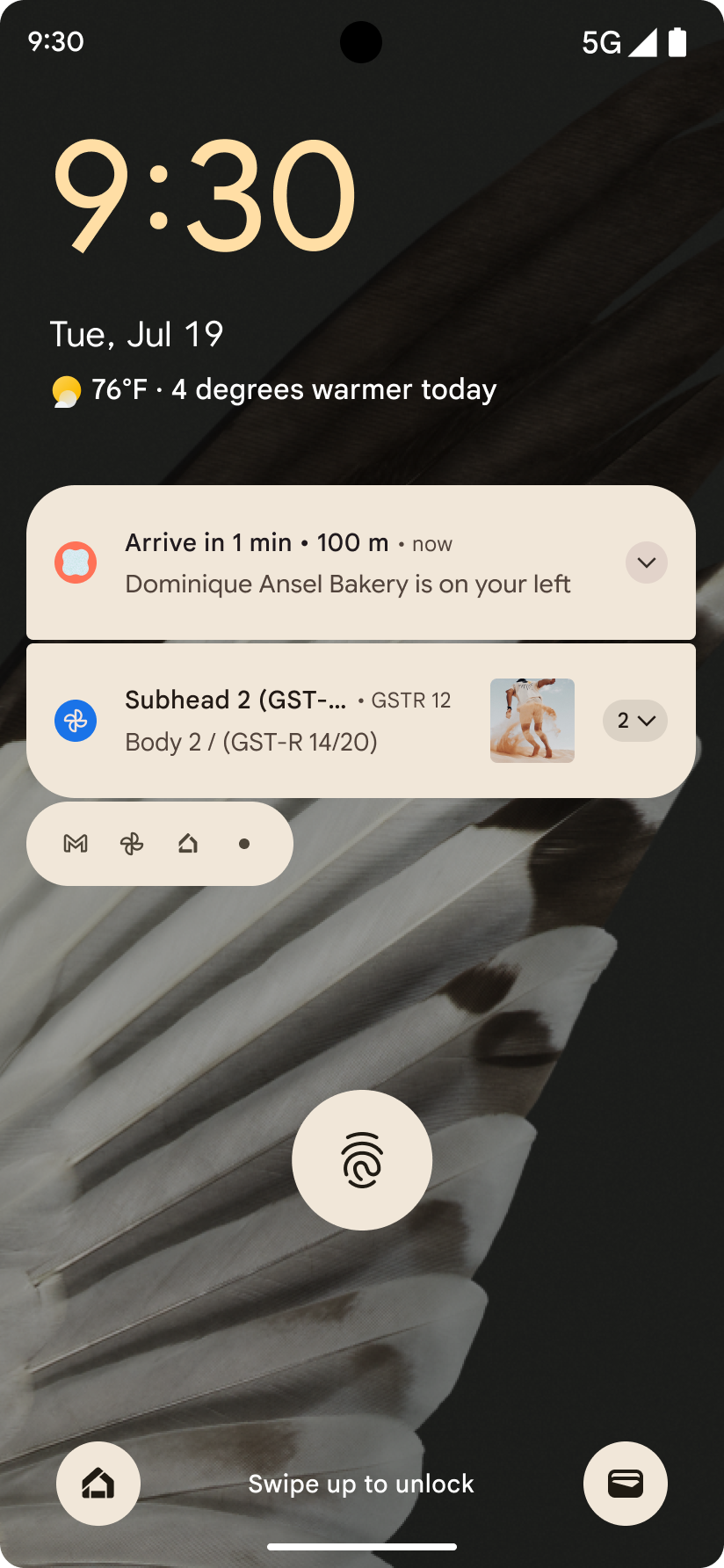
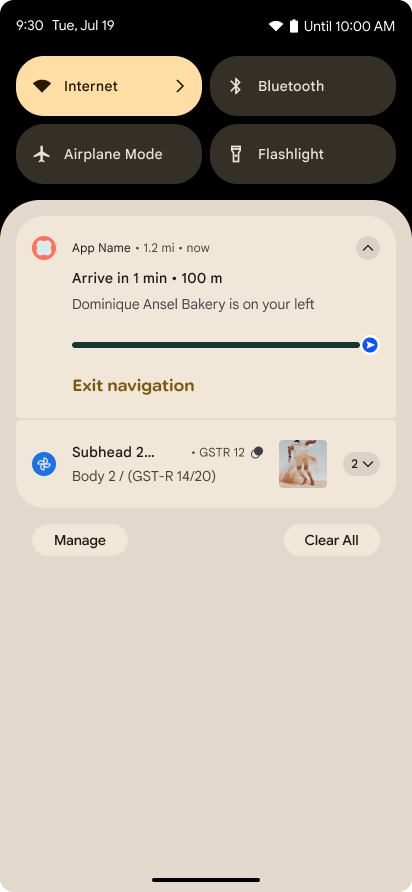
預測返回更新
Android 16 adds new APIs to help you enable predictive back system animations in
gesture navigation such as the back-to-home animation. Registering the
onBackInvokedCallback with the new
PRIORITY_SYSTEM_NAVIGATION_OBSERVER allows your app to
receive the regular onBackInvoked call whenever the
system handles a back navigation without impacting the normal back navigation
flow.
Android 16 additionally adds the
finishAndRemoveTaskCallback() and
moveTaskToBackCallback. By registering these callbacks
with the OnBackInvokedDispatcher, the system can trigger
specific behaviors and play corresponding ahead-of-time animations when the back
gesture is invoked.
更豐富的觸覺回饋
Android has exposed control over the haptic actuator ever since its inception.
Android 11 added support for more complex haptic effects that more advanced
actuators could support through
VibrationEffect.Compositions of device-defined semantic
primitives.
Android 16 adds haptic APIs that let apps define the amplitude and frequency curves of a haptic effect while abstracting away differences between device capabilities.
開發人員工作效率和工具
雖然我們大部分的工作都是圍繞著 Android Studio、Jetpack Compose 和 Android Jetpack 程式庫等工具,來改善您的工作效率,但我們也一直在尋找各種方法,透過平台協助您實現願景。
動態桌布的內容處理
在 Android 16 中,動態桌布架構會獲得新的內容 API,以解決動態、使用者導向桌布的挑戰。目前,整合使用者提供內容的動態桌布需要複雜的服務專屬實作項目。Android 16 推出 WallpaperDescription 和 WallpaperInstance。您可以使用 WallpaperDescription 識別同一個服務中動態桌布的不同例項。舉例來說,如果桌布同時出現在主畫面和螢幕鎖定畫面,則兩者可能會顯示不同的內容。桌布挑選器和 WallpaperManager 會使用這項中繼資料,為使用者提供更優質的桌布,讓您能以更簡便的方式打造多樣化且個人化的動態桌布體驗。
效能和電池
Android 16 推出了可協助收集應用程式深入分析資訊的 API。
系統觸發的剖析
ProfilingManager was
added in Android 15, giving apps the ability to
request profiling data collection using Perfetto on public devices in the field.
However, since this profiling must be started from the app, critical flows such
as startups or ANRs would be difficult or impossible for apps to capture.
To help with this, Android 16 introduces system-triggered profiling to
ProfilingManager. Apps can register interest in receiving traces for certain
triggers such as cold start reportFullyDrawn
or ANRs, and then the system starts and stops a trace on the app's behalf. After
the trace completes, the results are delivered to the app's data directory.
在 ApplicationStartInfo 中啟動元件
ApplicationStartInfo was added in Android
15, allowing an app to see reasons
for process start, start type, start times, throttling, and other useful
diagnostic data. Android 16 adds
getStartComponent()
to distinguish what component type triggered the start, which can be helpful for
optimizing the startup flow of your app.
更完善的工作內省功能
The JobScheduler#getPendingJobReason() API returns a reason why a job
might be pending. However, a job might be pending for multiple reasons.
In Android 16, we are introducing a new API
JobScheduler#getPendingJobReasons(int jobId), which returns multiple
reasons why a job is pending, due to both explicit constraints set by the
developer and implicit constraints set by the system.
We're also introducing
JobScheduler#getPendingJobReasonsHistory(int jobId), which returns a list
of the most recent constraint changes.
We recommend using the API to help you debug why your jobs may not be executing, especially if you're seeing reduced success rates of certain tasks or have bugs around latency of certain job completion. For example, updating widgets in the background failed to occur or prefetch job failed to be called prior to app start.
This can also better help you understand if certain jobs are not completing due to system defined constraints versus explicitly set constraints.
自動調整刷新率
在 Android 15 中推出的適應性重新整理率 (ARR) 可讓支援硬體的螢幕重新整理率,透過獨立的 VSync 步驟調整至內容影格速率。這麼做可降低耗電量,同時避免需要切換模式,進而導致卡頓現象。
Android 16 在還原 getSupportedRefreshRates() 時,會引入 hasArrSupport() 和 getSuggestedFrameRate(int),讓應用程式更容易利用 ARR。RecyclerView 1.4 在從彈跳或平滑捲動中進行調整時,會在內部支援 ARR,我們也持續致力於將 ARR 支援功能加入更多 Jetpack 程式庫。這篇關於影格速率的文章介紹許多可用來設定影格速率的 API,讓應用程式能直接使用 ARR。
ADPF 中的 Headroom API
The SystemHealthManager introduces the
getCpuHeadroom and
getGpuHeadroom APIs, designed to provide games and
resource-intensive apps with estimates of available CPU and GPU resources. These
methods offer a way for you to gauge how your app or game can best improve
system health, particularly when used in conjunction with other Android Dynamic
Performance Framework (ADPF) APIs that detect thermal
throttling.
By using CpuHeadroomParams and
GpuHeadroomParams on supported devices, you can
customize the time window used to compute the headroom and select between
average or minimum resource availability. This can help you reduce your CPU or
GPU resource usage accordingly, leading to better user experiences and improved
battery life.
無障礙設定
Android 16 新增了無障礙 API 和功能,可協助您將應用程式推廣給所有使用者。
改善無障礙 API
Android 16 新增了其他 API,可強化使用者介面語意,協助依賴無障礙服務 (例如 TalkBack) 的使用者提升一致性。
加外框的文字,可盡可能提高文字對比度
低視力使用者通常對對比敏感度較低,因此很難從背景中辨識物體。為協助這類使用者,Android 16 引進了外框文字,取代高對比文字,這項功能會在文字周圍繪製較大的對比區域,大幅提升易讀性。
Android 16 包含新的 AccessibilityManager API,可讓應用程式檢查或註冊事件監聽器,瞭解是否已啟用此模式。這項功能主要適用於 Compose 等 UI 工具包,可提供類似的視覺體驗。如果您維護 UI 工具包程式庫,或應用程式執行會略過 android.text.Layout 類別的自訂文字算繪作業,則可使用此方法瞭解何時啟用輪廓文字。
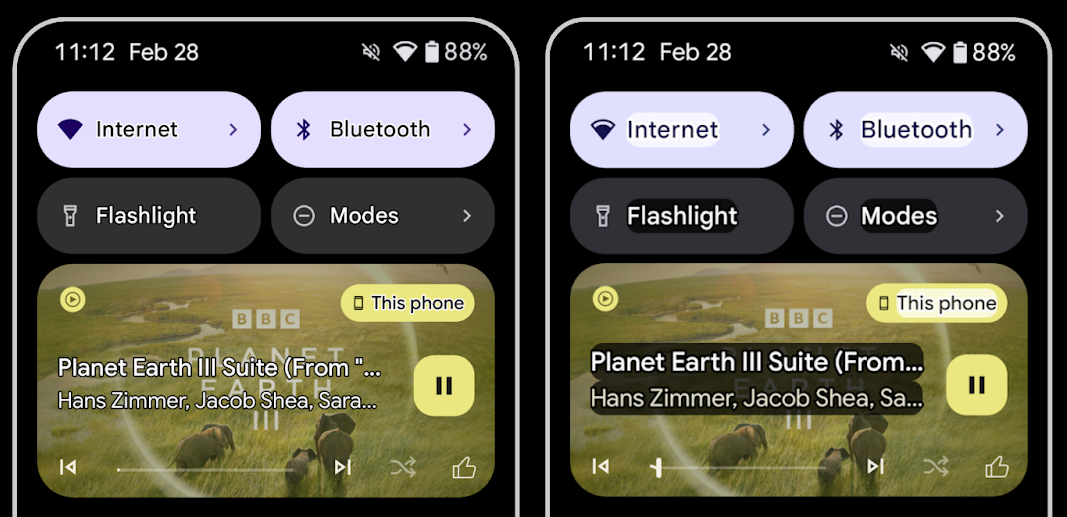
新增至 TtsSpan 的時間長度
Android 16 會使用 TYPE_DURATION 擴充 TtsSpan,其中包含 ARG_HOURS、ARG_MINUTES 和 ARG_SECONDS。這可讓您直接註解時間長度,確保 TalkBack 等服務能提供準確且一致的文字轉語音輸出內容。
支援含有多個標籤的元素
Android 目前允許 UI 元素從其他元素衍生無障礙標籤,現在則提供多個標籤的關聯功能,這也是網路內容的常見情境。在 AccessibilityNodeInfo 中導入以清單為基礎的 API,Android 即可直接支援這些多標籤關係。在本次異動中,我們已淘汰 AccessibilityNodeInfo#setLabeledBy 和 #getLabeledBy,改用 #addLabeledBy、#removeLabeledBy 和 #getLabeledByList。
改善對可展開元素的支援
Android 16 新增了無障礙 API,可讓您傳達互動元素 (例如選單和可展開清單) 的展開或收合狀態。您可以使用 setExpandedState 設定展開狀態,並搭配 CONTENT_CHANGE_TYPE_EXPANDED 內容變更類型調度 TYPE_WINDOW_CONTENT_CHANGED AccessibilityEvents,確保 TalkBack 等螢幕閱讀器會宣告狀態變更,提供更直覺且全面的使用者體驗。
不確定進度列
Android 16 新增了 RANGE_TYPE_INDETERMINATE,讓您可以為確定和不確定的 ProgressBar 小工具公開 RangeInfo,讓 TalkBack 等服務能更一致地提供進度指標的意見回饋。
三態核取方塊
Android 16 中的新 AccessibilityNodeInfo
getChecked 和 setChecked(int) 方法現在除了支援「已勾選」和「未勾選」之外,也支援「部分勾選」狀態。這會取代已淘汰的布林值 isChecked 和 setChecked(boolean)。
補充說明
無障礙服務說明 ViewGroup 時,會結合其子項檢視畫面的內容標籤。如果您為 ViewGroup 提供 contentDescription,無障礙服務會假設您也要覆寫無法聚焦的子項檢視畫面的說明。如果您想標示下拉式選單 (例如「字型系列」),同時保留現有無障礙選項 (例如「Roboto」),這可能會造成問題。Android 16 新增了 setSupplementalDescription,讓您可以提供文字,提供 ViewGroup 的相關資訊,而不會覆寫其子項的資訊。
必填表單欄位
Android 16 會將 setFieldRequired 新增至 AccessibilityNodeInfo,讓應用程式可向無障礙服務指出表單欄位需要輸入內容。對於填寫各種表單的使用者來說,這都是重要的情境,即使是像條款和條件核取方塊這類簡單的項目,也能協助使用者一貫地識別並快速瀏覽必要欄位。
使用手機麥克風輸入聲音,以便透過 LEA 助聽器進行語音通話
Android 16 adds the capability for users of LE Audio hearing aids to switch between the built-in microphones on the hearing aids and the microphone on their phone for voice calls. This can be helpful in noisy environments or other situations where the hearing aid's microphones might not perform well.
為 LEA 助聽器提供環境音量控制
Android 16 adds the capability for users of LE Audio hearing aids to adjust the volume of ambient sound that is picked up by the hearing aid's microphones. This can be helpful in situations where background noise is too loud or too quiet.
相機
Android 16 強化了對專業相機使用者的支援,可搭配混合式自動曝光功能,精準調整色溫和色調。新的夜間模式指標可協助應用程式瞭解何時切換至夜間模式相機工作階段,以及何時切換出去。新的 Intent 動作可讓你更輕鬆地拍攝動態相片,我們也持續改善 UltraHDR 圖片,支援 HEIC 編碼和 ISO 21496-1 草稿標準的新參數。
混合式自動曝光
Android 16 adds new hybrid auto-exposure modes to Camera2, allowing you to manually control specific aspects of exposure while letting the auto-exposure (AE) algorithm handle the rest. You can control ISO + AE, and exposure time + AE, providing greater flexibility compared to the current approach where you either have full manual control or rely entirely on auto-exposure.
fun setISOPriority() {
// ... (Your existing code before the snippet) ...
val availablePriorityModes = mStaticInfo.characteristics.get(
CameraCharacteristics.CONTROL_AE_AVAILABLE_PRIORITY_MODES
)
// ... (Your existing code between the snippets) ...
// Turn on AE mode to set priority mode
reqBuilder.set(
CaptureRequest.CONTROL_AE_MODE,
CameraMetadata.CONTROL_AE_MODE_ON
)
reqBuilder.set(
CaptureRequest.CONTROL_AE_PRIORITY_MODE,
CameraMetadata.CONTROL_AE_PRIORITY_MODE_SENSOR_SENSITIVITY_PRIORITY
)
reqBuilder.set(
CaptureRequest.SENSOR_SENSITIVITY,
TEST_SENSITIVITY_VALUE
)
val request: CaptureRequest = reqBuilder.build()
// ... (Your existing code after the snippet) ...
}
精確調整色溫和色調
Android 16 adds camera support for fine color temperature and tint adjustments
to better support professional video recording applications. In previous Android
versions, you could control white balance settings through
CONTROL_AWB_MODE, which contains options limited to a
preset list, such as Incandescent,
Cloudy, and Twilight. The
COLOR_CORRECTION_MODE_CCT enables the use of
COLOR_CORRECTION_COLOR_TEMPERATURE and
COLOR_CORRECTION_COLOR_TINT for precise adjustments of
white balance based on the correlated color temperature.
fun setCCT() {
// ... (Your existing code before this point) ...
val colorTemperatureRange: Range<Int> =
mStaticInfo.characteristics[CameraCharacteristics.COLOR_CORRECTION_COLOR_TEMPERATURE_RANGE]
// Set to manual mode to enable CCT mode
reqBuilder[CaptureRequest.CONTROL_AWB_MODE] = CameraMetadata.CONTROL_AWB_MODE_OFF
reqBuilder[CaptureRequest.COLOR_CORRECTION_MODE] = CameraMetadata.COLOR_CORRECTION_MODE_CCT
reqBuilder[CaptureRequest.COLOR_CORRECTION_COLOR_TEMPERATURE] = 5000
reqBuilder[CaptureRequest.COLOR_CORRECTION_COLOR_TINT] = 30
val request: CaptureRequest = reqBuilder.build()
// ... (Your existing code after this point) ...
}
The following examples show how a photo would look after applying different color temperature and tint adjustments:
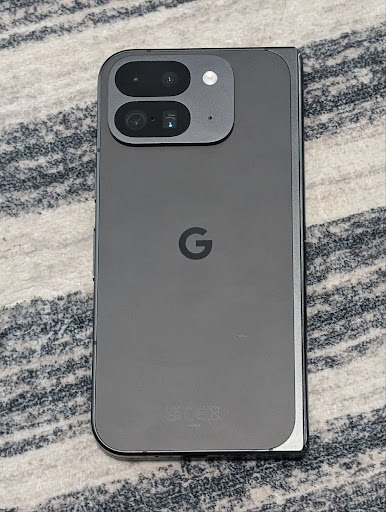

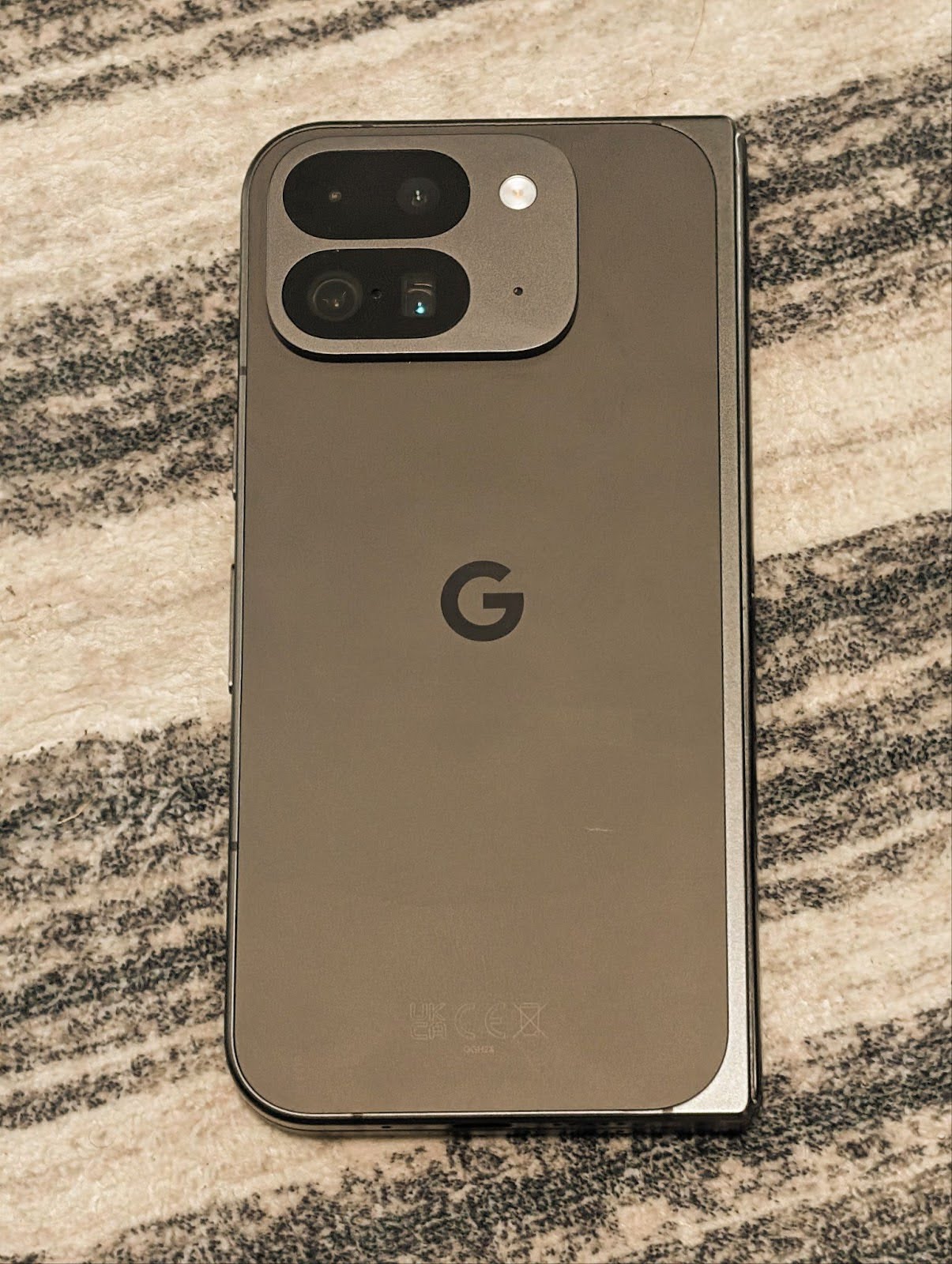

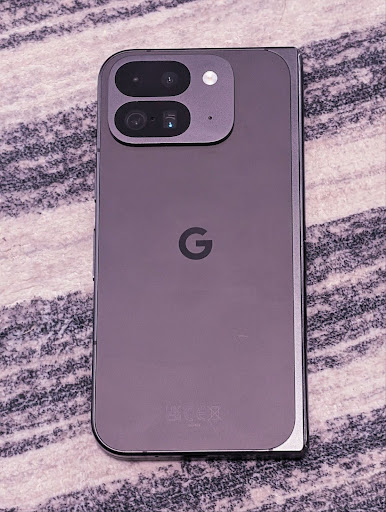
相機夜間模式場景偵測
To help your app know when to switch to and from a night mode camera session,
Android 16 adds EXTENSION_NIGHT_MODE_INDICATOR. If
supported, it's available in the CaptureResult within
Camera2.
This is the API we briefly mentioned as coming soon in the How Instagram enabled users to take stunning low light photos blog post. That post is a practical guide on how to implement night mode together with a case study that links higher-quality in-app night mode photos with an increase in the number of photos shared from the in-app camera.
動態相片拍攝意圖動作
Android 16 adds standard Intent actions —
ACTION_MOTION_PHOTO_CAPTURE, and
ACTION_MOTION_PHOTO_CAPTURE_SECURE — which request that
the camera application capture a motion photo and return
it.
You must either pass an extra EXTRA_OUTPUT to control
where the image will be written, or a Uri through
Intent.setClipData(ClipData). If you don't set a
ClipData, it will be copied there for you when calling
Context.startActivity(Intent).
UltraHDR 圖片強化功能
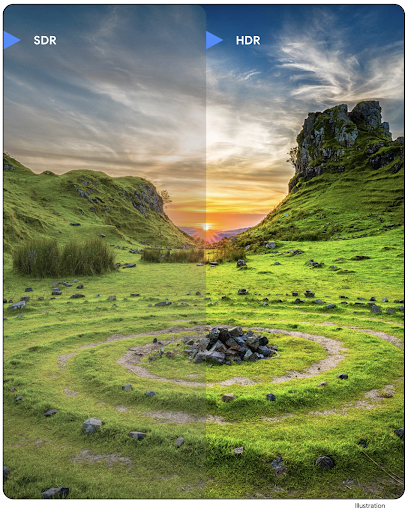
Android 16 持續致力於透過 UltraHDR 圖片提供令人驚豔的圖像品質。新增對 HEIC 檔案格式中的 UltraHDR 圖片支援。這些圖片會取得 ImageFormat 類型的 HEIC_ULTRAHDR,並包含類似現有 UltraHDR JPEG 格式的內嵌增益圖。我們也正在努力讓 AVIF 支援 UltraHDR,敬請期待。
此外,Android 16 會根據 ISO 21496-1 草稿標準,在 UltraHDR 中實作其他參數,包括取得及設定應套用的增益圖數值空間,以及支援 HDR 編碼的基礎圖片,並使用 SDR 增益圖。
圖形
Android 16 包含最新的圖形改善功能,例如使用 AGSL 的自訂圖形效果。
使用 AGSL 製作自訂圖形效果
Android 16 adds RuntimeColorFilter and
RuntimeXfermode, allowing you to author complex effects like
Threshold, Sepia, and Hue Saturation and apply them to draw calls. Since Android
13, you've been able to use AGSL to create custom
RuntimeShaders that extend Shader. The new API
mirrors this, adding an AGSL-powered RuntimeColorFilter that
extends ColorFilter, and a Xfermode effect that
lets you implement AGSL-based custom compositing and blending between source and
destination pixels.
private val thresholdEffectString = """
uniform half threshold;
half4 main(half4 c) {
half luminosity = dot(c.rgb, half3(0.2126, 0.7152, 0.0722));
half bw = step(threshold, luminosity);
return bw.xxx1 * c.a;
}"""
fun setCustomColorFilter(paint: Paint) {
val filter = RuntimeColorFilter(thresholdEffectString)
filter.setFloatUniform(0.5);
paint.colorFilter = filter
}
連線能力
Android 16 會更新平台,讓應用程式能夠使用最新的通訊和無線技術。
使用強化安全性的測距功能
Android 16 adds support for robust security features in Wi-Fi location on supported devices with Wi-Fi 6's 802.11az, allowing apps to combine the higher accuracy, greater scalability, and dynamic scheduling of the protocol with security enhancements including AES-256-based encryption and protection against MITM attacks. This allows it to be used more safely in proximity use cases, such as unlocking a laptop or a vehicle door. 802.11az is integrated with the Wi-Fi 6 standard, leveraging its infrastructure and capabilities for wider adoption and easier deployment.
泛用範圍 API
Android 16 包含新的 RangingManager,可用於判斷本機裝置與遠端裝置之間的距離和角度,前提是裝置支援硬體。RangingManager 支援各種測距技術,例如 BLE 通道測試、BLE RSSI 測距、超寬頻和 Wi-Fi 往返時間。
媒體
Android 16 包含多種可改善媒體體驗的功能。
相片挑選工具改善
The photo picker provides a safe, built-in way for users to grant your app access to selected images and videos from both local and cloud storage, instead of their entire media library. Using a combination of Modular System Components through Google System Updates and Google Play services, it's supported back to Android 4.4 (API level 19). Integration requires just a few lines of code with the associated Android Jetpack library.
Android 16 includes the following improvements to the photo picker:
- Embedded photo picker: New APIs that enable apps to embed the photo picker into their view hierarchy. This allows it to feel like a more integrated part of the app while still leveraging the process isolation that allows users to select media without the app needing overly broad permissions. To maximize compatibility across platform versions and simplify your integration, you'll want to use the forthcoming Android Jetpack library if you want to integrate the embedded photo picker.
- Cloud search in photo picker: New APIs that enable searching from the cloud media provider for the Android photo picker. Search functionality in the photo picker is coming soon.
進階專業影片
Android 16 推出了對進階專業影片 (APV) 轉碼器的支援,該轉碼器專為專業級高品質影片錄製和後製作業而設計。
APV 編碼器標準具有下列功能:
- 感知上無損的影片品質 (接近原始影片品質)
- 低複雜度和高吞吐量的單一影格編碼 (不含像素網域預測),以便更妥善支援編輯工作流程
- 支援高位元速率範圍 (最高可達數 Gbps),適用於 2K、4K 和 8K 解析度的內容,可透過輕量化熵值編碼方案啟用
- 為沉浸式內容和啟用平行編碼/解碼作業的框架平鋪作業
- 支援各種色度取樣格式和位元深度
- 支援多重解碼和重新編碼,且不會嚴重降低視覺品質
- 支援多視角影片和輔助影片,例如深度、alpha 和預覽
- 支援 HDR10/10+ 和使用者定義的中繼資料
OpenAPV 專案提供 APV 的參考實作項目。Android 16 將實作支援 APV 422-10 設定檔,提供 YUV 422 色彩取樣功能,以及 10 位元編碼和最高 2 Gbps 的目標位元率。
隱私權
Android 16 包含多種功能,可協助應用程式開發人員保護使用者隱私。
Health Connect 更新
Health Connect in the developer preview adds ACTIVITY_INTENSITY, a new
data type defined according to World Health Organization guidelines around
moderate and vigorous activity. Each record requires the start time, the end
time and whether the activity intensity is moderate or vigorous.
Health Connect also contains updated APIs supporting health records. This allows apps to read and write medical records in FHIR format with explicit user consent. This API is in an early access program. If you'd like to participate, sign up to be part of our early access program.
Android 版 Privacy Sandbox
Android 16 整合了最新版本的 Android 版 Privacy Sandbox,這是我們持續開發技術的一部分,讓使用者知道自己的隱私權受到保護。網站提供更多 Android 版 Privacy Sandbox 開發人員 Beta 版計畫的相關資訊,協助您開始使用。請查看 SDK 執行階段,讓 SDK 在專屬的執行階段環境中執行,而非在服務的應用程式中執行,以便在收集和分享使用者資料時提供更完善的防護。
安全性
Android 16 提供多項功能,可協助您強化應用程式的安全性,並保護應用程式的資料。
金鑰共用 API
Android 16 新增了 API,可支援與其他應用程式共用 Android KeyStore 金鑰的存取權。新的 KeyStoreManager 類別支援應用程式 uid 授予和撤銷金鑰存取權,並包含可讓應用程式存取共用金鑰的 API。
裝置板型規格
Android 16 可讓應用程式充分發揮 Android 板型規格的效益。
電視的標準影像和音訊品質架構
The new MediaQuality
package in Android 16 exposes
a set of standardized APIs for access to audio and picture profiles and
hardware-related settings. This allows streaming apps to query profiles and
apply them to media dynamically:
- Movies mastered with a wider dynamic range require greater color accuracy to see subtle details in shadows and adjust to ambient light, so a profile that prefers color accuracy over brightness may be appropriate.
- Live sporting events are often mastered with a narrow dynamic range, but are often watched in daylight, so a profile that preferences brightness over color accuracy can give better results.
- Fully interactive content wants minimal processing to reduce latency, and wants higher frame rates, which is why many TV's ship with a game profile.
The API allows apps to switch between profiles and users to enjoy tuning supported TVs to best suit their content.
國際化
Android 16 新增了功能和能力,可在使用不同語言的裝置上提供更完善的使用者體驗。
直書文字
Android 16 adds low-level support for rendering and measuring text vertically to
provide foundational vertical writing support for library developers. This is
particularly useful for languages like Japanese that commonly use vertical
writing systems. A new flag,
VERTICAL_TEXT_FLAG,
has been added to the Paint class. When
this flag is set using
Paint.setFlags, Paint's
text measurement APIs will report vertical advances instead of horizontal
advances, and Canvas will draw text
vertically.
val text = "「春は、曙。」"
Box(
Modifier.padding(innerPadding).background(Color.White).fillMaxSize().drawWithContent {
drawIntoCanvas { canvas ->
val paint = Paint().apply { textSize = 64.sp.toPx() }
// Draw text vertically
paint.flags = paint.flags or VERTICAL_TEXT_FLAG
val height = paint.measureText(text)
canvas.nativeCanvas.drawText(
text,
0,
text.length,
size.width / 2,
(size.height - height) / 2,
paint
)
}
}
) {}
自訂測量系統
Users can now customize their measurement system in regional preferences within
Settings. The user preference is included as part of the locale code, so you can
register a BroadcastReceiver on
ACTION_LOCALE_CHANGED to handle locale configuration changes when
regional preferences change.
Using formatters can help match the local experience. For example, "0.5 in" in English (United States), is "12,7 mm" for a user who has set their phone to English (Denmark) or who uses their phone in English (United States) with the metric system as the measurement system preference.
To find these settings, open the Settings app and navigate to System > Languages & region.

